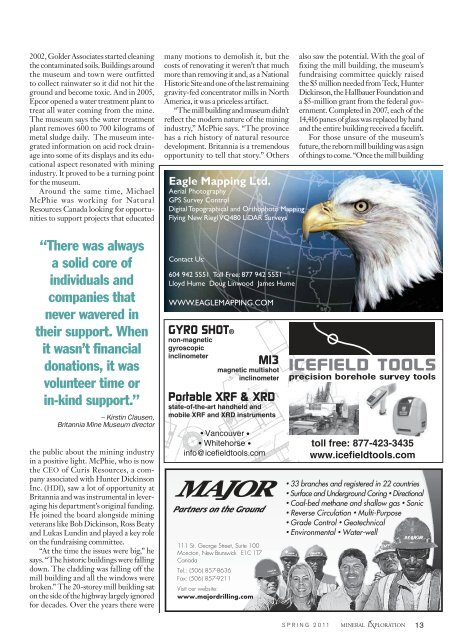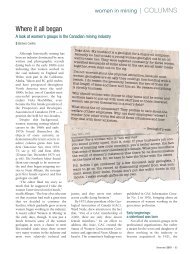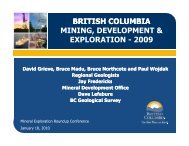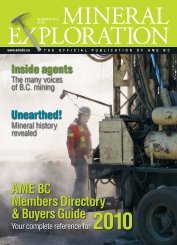Spring 2011 - The Association for Mineral Exploration British Columbia
Spring 2011 - The Association for Mineral Exploration British Columbia
Spring 2011 - The Association for Mineral Exploration British Columbia
Create successful ePaper yourself
Turn your PDF publications into a flip-book with our unique Google optimized e-Paper software.
2002, Golder Associates started cleaning<br />
the contaminated soils. Buildings around<br />
the museum and town were outfitted<br />
to collect rainwater so it did not hit the<br />
ground and become toxic. And in 2005,<br />
Epcor opened a water treatment plant to<br />
treat all water coming from the mine.<br />
<strong>The</strong> museum says the water treatment<br />
plant removes 600 to 700 kilograms of<br />
metal sludge daily. <strong>The</strong> museum integrated<br />
in<strong>for</strong>mation on acid rock drainage<br />
into some of its displays and its educational<br />
aspect resonated with mining<br />
industry. It proved to be a turning point<br />
<strong>for</strong> the museum.<br />
Around the same time, Michael<br />
McPhie was working <strong>for</strong> Natural<br />
Resources Canada looking <strong>for</strong> opportunities<br />
to support projects that educated<br />
“<strong>The</strong>re was always<br />
a solid core of<br />
individuals and<br />
companies that<br />
never wavered in<br />
their support. When<br />
it wasn’t financial<br />
donations, it was<br />
volunteer time or<br />
in-kind support.”<br />
– Kirstin Clausen,<br />
Britannia Mine Museum director<br />
the public about the mining industry<br />
in a positive light. McPhie, who is now<br />
the CEO of Curis Resources, a company<br />
associated with Hunter Dickinson<br />
Inc. (HDI), saw a lot of opportunity at<br />
Britannia and was instrumental in leveraging<br />
his department’s original funding.<br />
He joined the board alongside mining<br />
veterans like Bob Dickinson, Ross Beaty<br />
and Lukas Lundin and played a key role<br />
on the fundraising committee.<br />
“At the time the issues were big,” he<br />
says. “<strong>The</strong> historic buildings were falling<br />
down. <strong>The</strong> cladding was falling off the<br />
mill building and all the windows were<br />
broken.” <strong>The</strong> 20-storey mill building sat<br />
on the side of the highway largely ignored<br />
<strong>for</strong> decades. Over the years there were<br />
many motions to demolish it, but the<br />
costs of renovating it weren’t that much<br />
more than removing it and, as a National<br />
Historic Site and one of the last remaining<br />
gravity-fed concentrator mills in North<br />
America, it was a priceless artifact.<br />
“<strong>The</strong> mill building and museum didn’t<br />
reflect the modern nature of the mining<br />
industry,” McPhie says. “<strong>The</strong> province<br />
has a rich history of natural resource<br />
development. Britannia is a tremendous<br />
opportunity to tell that story.” Others<br />
also saw the potential. With the goal of<br />
fixing the mill building, the museum’s<br />
fundraising committee quickly raised<br />
the $5 million needed from Teck, Hunter<br />
Dickinson, the Hallbauer Foundation and<br />
a $5-million grant from the federal government.<br />
Completed in 2007, each of the<br />
14,416 panes of glass was replaced by hand<br />
and the entire building received a facelift.<br />
For those unsure of the museum’s<br />
future, the reborn mill building was a sign<br />
of things to come. “Once the mill building<br />
SPRING <strong>2011</strong> 13





